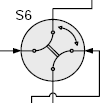| Overview | Package | Class | Use | Tree | Deprecated | Index | Help |

|

|
|||||||||
| PREV CLASS NEXT CLASS | FRAMES NO FRAMES | |||||||||
| SUMMARY: NESTED | FIELD | CONSTR | METHOD | DETAIL: FIELD | CONSTR | METHOD | |||||||||
java.lang.Objectedu.nrao.sss.electronics.SignalTransferSwitch
public class SignalTransferSwitch
A special kind of switch that provides a one-to-one mapping of its N input poles to its N output poles. A given input may be connected to either its immediate clockwise or immediate counterclockwise neighbor.
| The following is an example taken from the EVLA Antenna Block Diagram whose N value is 2: |  |
Version Info:
| $Revision: 1035 $ |
| $Date: 2008-01-10 16:49:07 -0700 (Thu, 10 Jan 2008) $ |
| $Author: dharland $ (last person to modify) |
| Constructor Summary | |
|---|---|
SignalTransferSwitch(String deviceName,
int numInputs)
Creates a new transfer switch with the number of input and output poles set to numInputs. |
|
| Method Summary | |
|---|---|
void |
execute()
Runs the inputs to this switch from their beginnings and then executes the output pipes of this device. |
void |
executeFromStartOfChainUpTo(SignalProcessor firstUnexecutedDevice)
Retreats upstream from this processor to the source of the stream and executes that device(s), telling it to stop execution at firstUnexecutedDevice. |
void |
executeUpTo(SignalProcessor firstUnexecutedDevice)
Executes this device and all downstream devices up to, but not including, the firstUnexecutedDevice. |
SignalPipe |
getInputPipe(int index)
Returns the indexth input pipe of this device. |
String |
getName()
Returns the name of this switch. |
SignalPipe |
getOutputPipe(int index)
Returns the indexth output pipe of this device. |
boolean |
isSetToClockwise()
Returns true if this switch is set such that the inputs are piped to the outputs in a clockwise direction. |
void |
setToClockwiseOutputs()
Sets this switch so that its inputs are connected to their clockwise outputs. |
void |
setToCounterclockwiseOutputs()
Sets this switch so that its inputs are connected to their anticlockwise outputs. |
void |
twist()
Turns this switch so that all the inputs now use their other outputs. |
| Methods inherited from class java.lang.Object |
|---|
clone, equals, finalize, getClass, hashCode, notify, notifyAll, toString, wait, wait, wait |
| Constructor Detail |
|---|
public SignalTransferSwitch(String deviceName,
int numInputs)
numInputs. The returned switch is initially configured
so that inputs are connected to their clockwise outputs.
deviceName - an optional name for this switch. If this value is null
a default name will be used in its place.numInputs - the number of input and output poles on this switch.| Method Detail |
|---|
public String getName()
public void twist()
public void setToClockwiseOutputs()
public void setToCounterclockwiseOutputs()
public boolean isSetToClockwise()
public SignalPipe getInputPipe(int index)
indexth input pipe of this device.
A typical usage pattern for this method is:mySwitch.getInputPipe(p).connectInputTo(mySource);
Indexing begins at zero.
indexth input pipe of this device.public SignalPipe getOutputPipe(int index)
indexth output pipe of this device.
A typical usage pattern for this method is:mySwitch.getOutputPipe(p).connectOutputTo(myProcessor);
Indexing begins at zero.
indexth output pipe of this device.public void execute()
execute in interface SignalProcessorpublic void executeUpTo(SignalProcessor firstUnexecutedDevice)
SignalProcessorfirstUnexecutedDevice.
See SignalProcessor.execute() for more information about the linking
of processors.
executeUpTo in interface SignalProcessorfirstUnexecutedDevice - the first device downstream that is not to be executed.
If all downstream devices should be executed you may use a
null value here or call SignalProcessor.execute().public void executeFromStartOfChainUpTo(SignalProcessor firstUnexecutedDevice)
SignalProcessorfirstUnexecutedDevice.
executeFromStartOfChainUpTo in interface SignalProcessorfirstUnexecutedDevice - the first device in a chain of processors that is not
to be executed.
If all devices should be executed you may use a
null value here.
The first unexecuted device should be downstream of this
device.
|
|
|||||||||
| PREV CLASS NEXT CLASS | FRAMES NO FRAMES | |||||||||
| SUMMARY: NESTED | FIELD | CONSTR | METHOD | DETAIL: FIELD | CONSTR | METHOD | |||||||||